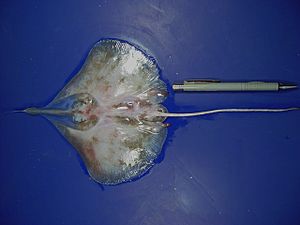Leaf-nose leg skate facts for kids
Quick facts for kids Springeria folirostris |
|
|---|---|
 |
|
| Conservation status | |
| Scientific classification | |
| Kingdom: | |
| Phylum: | |
| Class: | |
| Order: |
Rajiformes
|
| Family: |
Anacanthobatidae
|
| Genus: |
Springeria
|
| Species: |
S. folirostris
|
| Binomial name | |
| Springeria folirostris Bigelow & Schroeder, 1951
|
|
| Synonyms | |
|
Anacanthobatis folirostris |
|
The leaf-nose leg skate (Springeria folirostris) is a special type of ray that lives in the deep ocean. It belongs to a family of rays called Anacanthobatidae. This unique fish was first discovered and named in 1951 by scientists Henry Bryant Bigelow and William Charles Schroeder.
About the Leaf-Nose Leg Skate
Leaf-nose leg skates are fascinating creatures of the deep sea. Like other rays, they are related to sharks because they have skeletons made of cartilage instead of bone. They are known for their flat bodies and long, thin tails. The "leaf-nose" part of their name comes from the shape of their snout.
Where the Leaf-Nose Leg Skate Lives
You can find the leaf-nose leg skate in the Gulf of Mexico. It prefers to live in very deep waters, usually between 300 and 510 meters (about 980 to 1,670 feet) below the surface. This deep-sea environment is dark and cold, which is perfect for this skate.
Its Scientific Name Story
When the leaf-nose leg skate was first found, scientists gave it the name Springeria folirostris. Later, some scientists thought it should be part of a different group, so they called it Anacanthobatis folirostris. But in 2016, after more research, scientists decided that Springeria was indeed its own special group again. This shows how scientists keep learning and sometimes change how they classify animals as they discover more about them.


